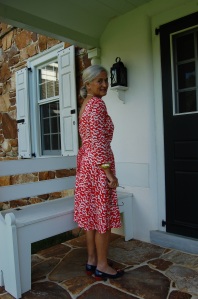Forty years ago this month – October of 1976 – the first Diane von Furstenberg Vogue patterns were available for purchase. At the same time, Cohama (fabrics) produced Diane von Furstenberg-designed knits specifically for use with those patterns. Both were detailed in the September/October 1976 edition of Vogue Pattern Book Magazine:

One of the Diane von Furstenberg designs I long admired but never purchased when I was sewing for myself in the 1970s was this pattern:

I never quite believed that it could really be reversible; I just especially liked the front wrapped version. So when I had the opportunity to purchase this pattern a few years ago online, I jumped at it. Then not long after, one of my blog readers contacted me with some vintage Cohama DvF fabric for sale. She so kindly gave me first choice of what she had, and I purchased two lengths from her. The first piece of fabric I made into this dress:

The second piece was this “Birds” design, and I was fortunate enough to have over three yards available to me:


The selvedge clearly states the DvF connection.
How I waited THIS LONG to make this dress, I’ll never know, but now it is reality!

Worn with the V and wrap to the back.

Worn with the V and wrap to the front.
DvF-designed Cohama knit fabric is a lovely cotton/rayon blend, very soft and surprisingly easy to sew. I am not a big fan – or any fan at all, really – of sewing with knits, so I appreciate that this fabric is so accommodating. One downside of sewing with knits that I can’t quite get around is the fact that it is almost impossible to make a muslin mock-up to try out the fit and sizing. Perhaps someone knows some trick that I don’t know, but I felt a little like I was flying blind when making adjustments to the pattern which I would need for the proper fit. These included 1) lengthening the bodice by about an inch (which I know needs to be done from other wrap dresses I have made), 2) shortening the sleeves to three-quarter length and adding a little bit of width to them so they could be pushed up comfortably, and 3) adding about an inch and a half to the diameter of the waistline. Even with the forgiving nature of a knit fabric, I am not comfortable making a dress without a proper muslin first – so I was a little bit nervous the whole way through the construction of this dress.
I followed the instructions carefully, and was fascinated to find that all the seams needed to be double-stitched, trimmed and pressed to one side. I discovered the reason for this after the dress was finished – it helps make the dress truly reversible, in some magical way.

A side and waist seam detail. Yes, this dress has pockets – two of them!

I did, however, use my trusty Snug Hug seam binding for the front skirt facings and the hem.
I needed an iron-on interfacing suitable for use with knits and after some research came up with Heat-n-Bond Fusible tricot (purchased from Fabrics.com.) This is the perfect interfacing for use with knits as it stretches, but also stabilizes. I used it for the neck and front facings per the pattern instructions, and I also reinforced the hems in the sleeves. The pattern called for under-stitching the front and neck facing, and I could not help myself – I did it by hand rather than machine!

Hand finishing is just so much nicer!

I was fortunate enough to receive a label with the pattern! You can see a small strip of the fusible interfacing showing beyond the edge of the facing…
In the description of this pattern in the Vogue Pattern Book Magazine, it states: “Night & Day, Diane is the one! She wraps up both scenes in one pattern! Her wizard [my emphasis] wrap (that reverses front to back)… [for] day with plunge to front and …[for] night with plunge to back.”
Plunge is right! When I tried on the dress with the wrap to the front, I decided I was going to have to add a modesty panel or a very strong snap to keep the front closed. I opted for the snap, but I’m not entirely happy with the way it looks.

I should have taken a closeup of the bodice!

There seem to be a few wrinkles across the back.

I so prefer three-quarter length sleeves rather than long sleeves, particularly in a dress like this which will be worn in the warmer months.
When I tried on the dress with the wrap to the back, I loved it, and I felt like it fit me better, especially across the shoulders.


The back without the snap fastened.


Now the dilemma: I need the snap for the front V, but I don’t need it for the back V, nor can I reach it by myself in the back to fasten it. But one half of the snap shows when the V is in the back, which obviously will not do! If I take the snap off, I cannot wear the dress with the front V (which is a little more casual look.) If I leave the snap on, I cannot wear the dress with the back V (a little dressier look.) Maybe I should forgo the snap and make a modesty panel, which can fasten underneath and be removed when I wear the dress “backwards.” Any thoughts, anyone??
I guess I have the advantage of time on my side to figure this out, as I probably will not, at this point, be wearing this dress until next Spring. Despite this one little gaping issue, I think this dress is beautiful, versatile, comfortable and very feminine!
Hooray for Diane von Furstenberg, vintage Vogue Patterns and vintage Cohama fabrics – some styles never get old!


















